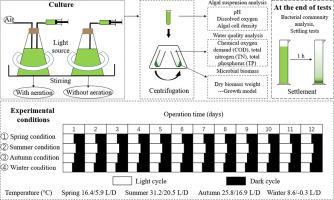Algal Research ( IF 5.1 ) Pub Date : 2020-12-26 , DOI: 10.1016/j.algal.2020.102175 Kaiwei Xu , Xiaotong Zou , Yating Xue , Yanhui Qu , Yanpeng Li

|
The co-cultivation of microalgae and bacteria has become an attractive approach for treating wastewater. This approach can achieve both cost-effective nutrient removal and biomass resource recovery. However, the development of full-scale algae-bacteria systems or enhanced pond systems has been limited, because of the complexity and changeability of environmental factors in this process. This study investigated the effects of seasonal variations about temperature and photoperiod on municipal wastewater treatment by algae-bacteria system in lab-scale. Nutrient removal, biomass growth, settling ability, and community structures were examined using cultures of Chlorella vulgaris, Scenedesmus obliquus, Spirulina platensis, and aerobic activated sludge in raw municipal wastewater. Results showed that the nutrient removal and biomass yield varied with seasonal conditions. High removal rates and biomass production percentages were achieved in summer and autumn conditions with aeration. The highest specific growth rate was 0.46 d−1; the highest total nitrogen removal rate was 2.34 d−1; and the highest total suspended solids removal efficiency was 96.3 ± 2.1% in summer conditions with aeration. The highest total phosphorus removal rate was 1.67 d−1 in the autumn season with aeration. An overall analysis indicated that Chlorella vulgaris and Scenedesmus obliquus, combined with bacteria (Proteobacteria, Firmicutes, Bacteroidetes, Chloroflexi) can effectively use different carbon, nitrogen, and phosphorus sources from wastewater in summer and autumn conditions. Further research should focus on methods for effectively and inexpensively improving nutrient removal and recovering biomass at low temperatures and with short photoperiods.
中文翻译:

温度和光周期的季节性变化对实验室规模的藻类细菌系统处理城市废水的影响
微藻类和细菌的共培养已成为一种有吸引力的废水处理方法。这种方法可以实现具有成本效益的营养去除和生物质资源的回收。但是,由于在此过程中环境因素的复杂性和可变性,因此发展大型藻类细菌系统或增强池塘系统受到了限制。本研究在实验室范围内研究了温度和光周期的季节性变化对藻类细菌系统处理城市废水的影响。使用小球藻,斜生藻,钝顶螺旋藻的培养物检测养分去除,生物量生长,沉降能力和群落结构,以及市政污水中的好氧活性污泥。结果表明,养分去除和生物量产量随季节条件而变化。在夏季和秋季条件下,通气可实现较高的去除率和生物质生产百分比。最高比生长率为0.46 d -1 ; 最高总脱氮率为2.34 d -1 ; 在夏季通风条件下,最高的总悬浮固体去除效率为96.3±2.1%。在通气的秋季,总磷去除率最高为1.67 d -1。总体分析表明,小球藻和斜生小球藻结合细菌(变形杆菌,菌毛菌,拟杆菌属,叶挠菌)可以在夏季和秋季条件下有效利用废水中的不同碳,氮和磷来源。进一步的研究应集中于在低温和短光周期下有效和廉价地提高营养去除率和回收生物量的方法。



























 京公网安备 11010802027423号
京公网安备 11010802027423号